Christmas may not seem all that different in Catalonia.
Homes glow with the white or multi-colored lights of Christmas trees. Cookies and cakes abound. Elaborate nativity scenes depict the birth of Jesus.
Within this scene of yuletide tranquility, however, is the key to the Christmas season in Catalonia.
Amid the somber faces of the wise men, the adoring gaze of Mary, the serene look on the Christ child’s face and the satisfied countenance of the angels is an anomaly; a very Catalán anomaly.
A man in a Catalán barretina red cap, white shirt and dark pants is squatting, his trousers halfway to the ground. Beneath his milky-white cheeks lies a pile of…
Read on to discover the traditions, the days of celebration and the food which represent the holidays in Barcelonoa
Christmas Catalán Style
THE TRADITIONS
Christmas in Catalonia is a cultural affair in which curious traditions give you a picture of the cheeky, agrarian characteristics of Catalan heritage. Let´s begin with the caganer.
The Caganer: Catalonia’s Favorite Nativity Photobomber
One of the many explanations of the origins of the caganer goes like this: In a manner befitting of resourceful farmers, they left Jesus a pile of poop. Why poop? Because feces is a fantastic fertilizer of soil and by fertilizing the soil of the manger scene the caganer guaranteed the continued existence of the manger. It’s was the ultimate — albeit rustic — sign of respect from a farmer to a family.
Regardless of the origins of the caganer, Cataláns pay homage to this interesting tradition by including a caganer (“pooper”, in PG verbiage) figurine in their nativity scenes.
Here are two great photos of said caganer, one of the cheeky fellow up close and one of him perched in the upper reaches of the nativity stable.
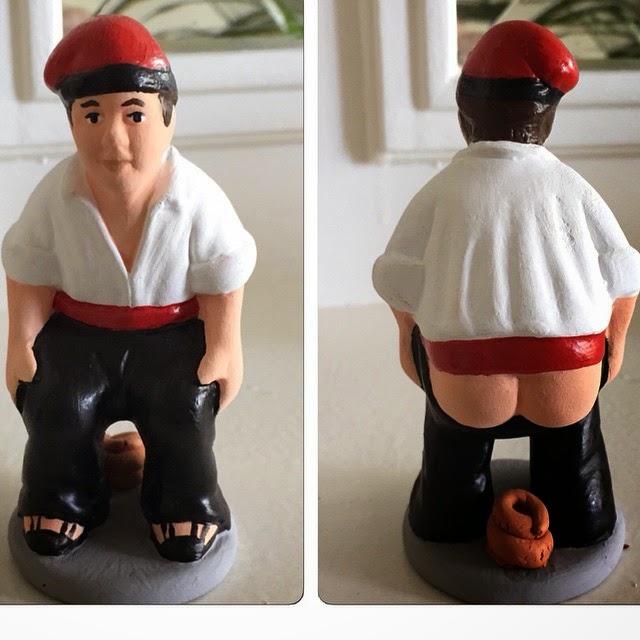 |
| Fair of foul? The caganer is a regular alongside Mary, Joseph, Jesus and the wise men |
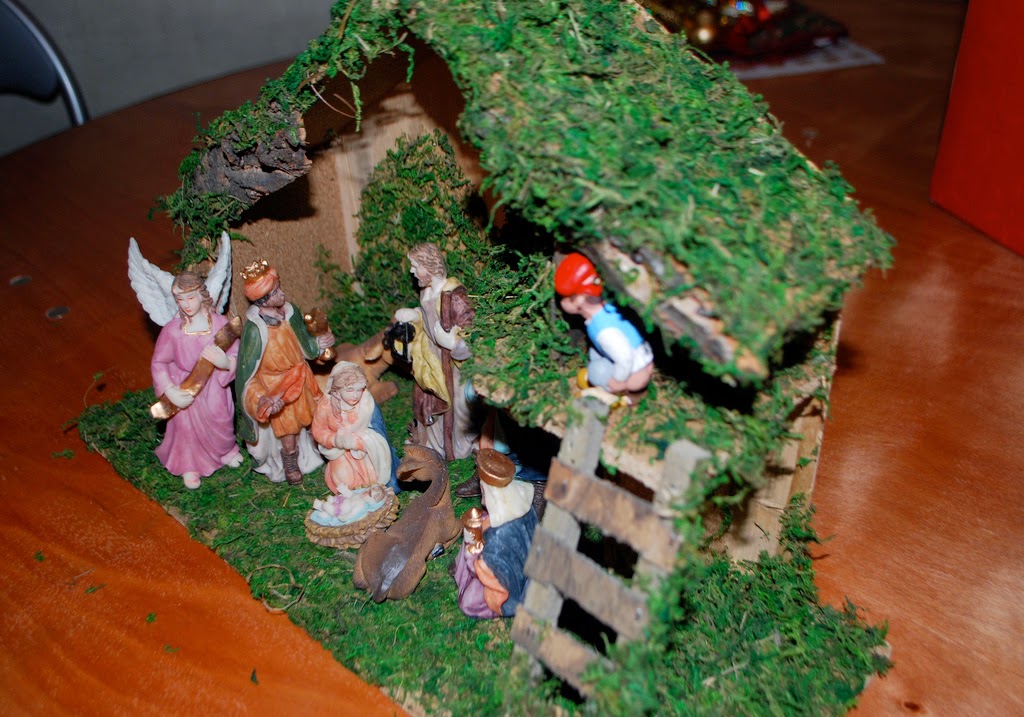 |
| Always present, always pooping |
The Caga Tio: Bearing Gifts From Behind
When Catalan kids gather around their Christmas tree to open their first presents of the season, the celebration doesn´t go quite like you think.
Standing between their dreams of stocking-stuffer candies and goodies stands a sqautty, two-legged log who, despite multiple future beatings, will refuse to give up the presents for which the children long.
Part of the coaxing of the presents from the lazy log is the fine art of bribing; like kids in the United States, Catalán kids will treats and snacks for Caga Tio’s eatomg
Caga Tio, which means, loosely, Pooping Log (again, a PG translation), is a log fitted with two legs. The front of the log is painted with a smiley face and usually fitted with a typical black-and-red barretina hat.
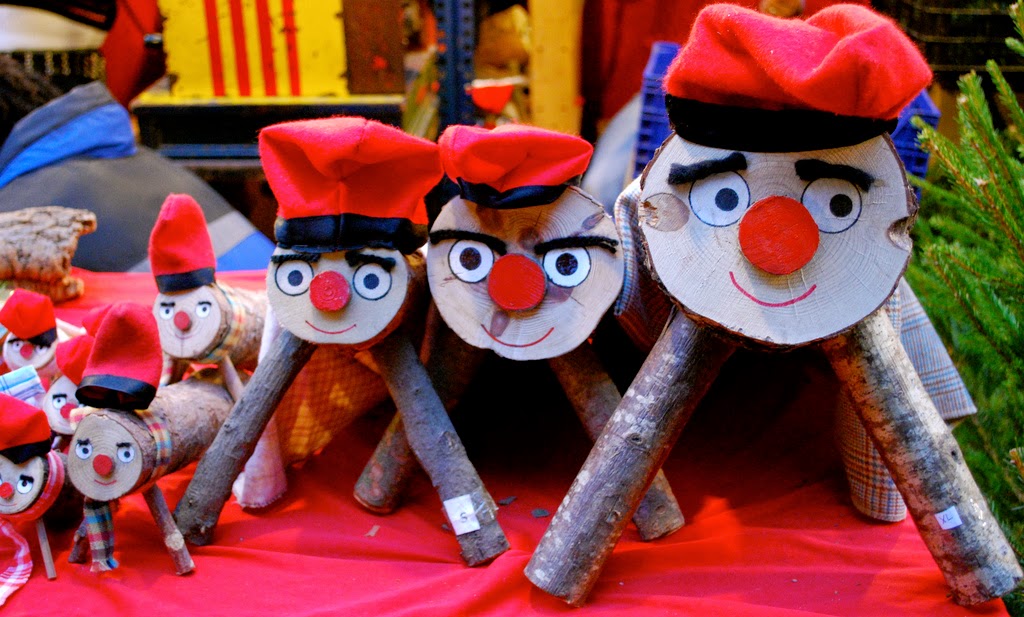 |
| Good luck getting some stocking stuffers out of this guy |
Come Christmas Day, the children gather around the log and sing a song. As they serenade the little log, they take a stick and hit Caga Tio in the hope that he “excretes” presents which are hidden under the blanket.
The grumpy old log usually doesn’t relent after the first pummeling. Multiple serenades are required. When Caga Tio is satisfied, his blanket is removed to reveal a pile of candies, which almost always include turron, a delicious almond nougat beloved in Catalonia.
When Caga Tio is pooped from the difficult labor of offering up turron, he signals the end of his generosity by dropping a salted herring.
This video by Norah Jones is a perfect example of the tradition (sung in French, includes English subtitles):
The Christmas Market:
A One-Stop Shopping Adventure For All-Things Holiday
Mid-November marks the beginning Barcelona’s Christmas markets, one of the most fun traditions of the holiday season in the Catalonian capital. The Christmas markets are located at the large plaza in front of the Gothic Quarter’s Barcelona Cathedral, as well as in the large park in front of La Sagrada Familia.
The markets are crammed with vendor stalls, which in turn are crammed with all sorts of trinkets and treats for the holiday season. These markets are the premier location for finding the perfect caganer for your nativity scene.
Though traditionally-dressed figurines were the first type of caganers, the famed figurine has kept up with modern trends. You can find caganers of all types now, from world leaders to soccer stars.
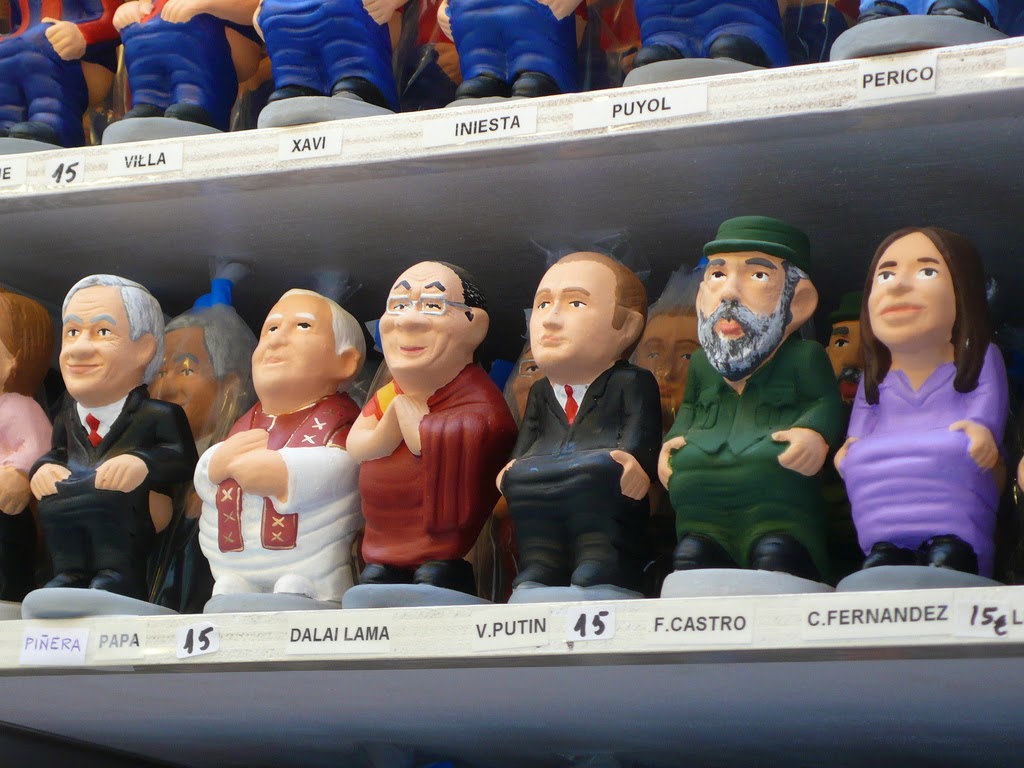 |
| From soccer stars to socialists, caganers have become a global enterprise |
Tongue-in-cheek trinkets aren’t the only specialty of the markets, though. You can find everything you need for the perfect nativity scene.
Christmas trees also abound at the markets. Many times you’ll find strapping dads lugging hog-tied trees away from the market as overjoyed children tag along.
Flowers, wreaths and a host of other things are available for sale at the markets.
The markets are usually packed with people, smiles and culture. It’s an experience you shouldn’t miss if you’re in town for the holidays. The markets are a great place to find a culturally relevant souvenir for friends and family.
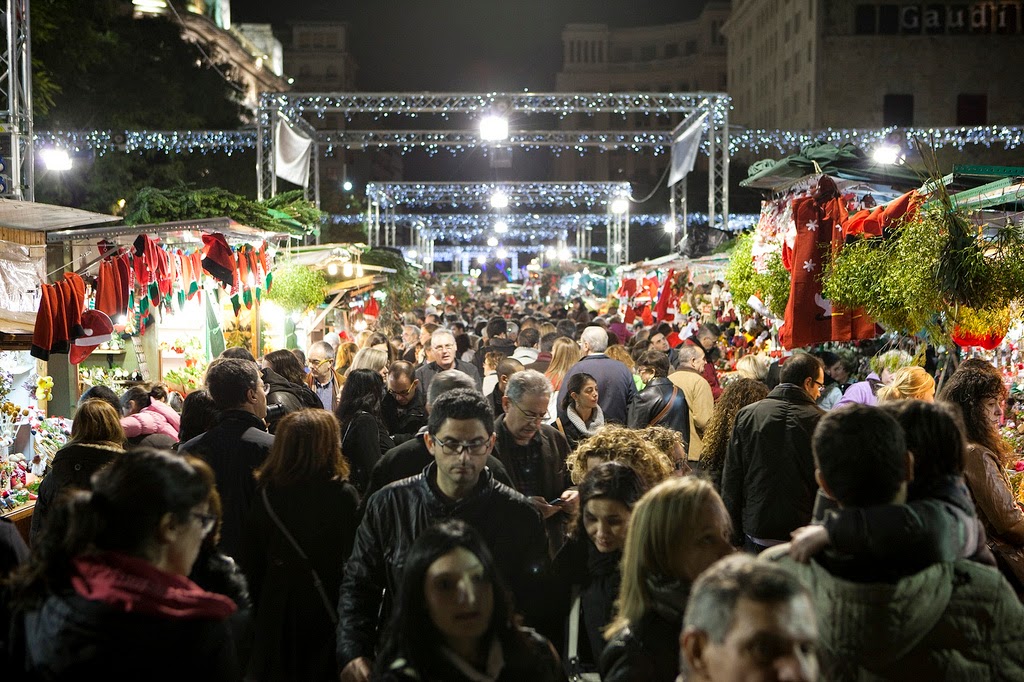 |
| Christmas, Barcelona style |
The Christmas Train:
Chugging Through the Holidays
The program is designed for kids and, as of last year, cost 1 euro per journey. The trip, however, is fun for both young and old.
We recommend taking the blue line (L5) to El Carmel, where the neighborhood’s train is known to take full advantage of the area’s many hills by zipping around corners and launching itself down inclines at modest speeds which bring a smile to — and the occasional scream from — the faces of its passengers.
Here’s a video of the El Carmel Christmas train:
THE DAYS OF CELEBRATION
Christmas (Dec. 25)
Saint Steven’s Day (Dec. 26)
Three Kings: Bearing Gifts From Afar (Jan. 5)
When it comes to the big-money presents which can’t fit under Caga Tio’s modest blanket, Catalan kids turn to the Three Kings.
Three Kings is a holiday celebrated on January 5, in which the wise men who brought Jesus gifts bring presents to kids.
Neighborhoods around Barcelona celebrate the special day by hosting parades. The Three Kings are a generous lot; in most cases, they throw hundreds of pieces of candy to the hundreds of people watching excitedly as the kings move along the parade route.
Parade floats are awash in bright lights and festive, costumed characters. Along with the parade are Christmas lights which are suspended over the streets of each neighborhood’s business district.
The lights are paid for by local merchants. They add beauty and charm to Barcelona’s barrios during the Christmas season and are put up in the middle of November.
Here’s a video of the Three Kings parade in Barcelona’s Horta-Guinardo district:
THE FOOD
Turron: A Can’t-Miss Catalan Treat
Remember that wily little log, Caga Tio? His favorite yuletide excretion is turrón, a holiday treat made from various types of ingredients.
Turron is rectangular in shape and usually comes wrapped in air-tight plastic packaging. One of the most popular forms of turron is the turron de agramunt. This turron is chewy in texture, sticky to the touch and includes whole nuts.
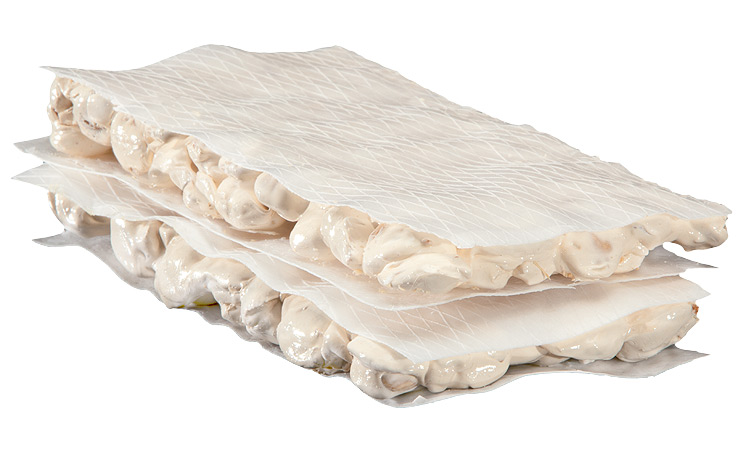 |
| Thank you, Caga Tio! |
Turron blanda is another type of popular turron. It has a simple, semi-sweet taste and a soft, fluffy texture. Unlike turron agramunt, blanda does not contain whole nuts.
Turron yema is another favorite. Yema is made from egg yolk, is moist and has a soft texture to it and, usually, golden yellow color.
The delectable dessert is available year-round in Catalonia, but it’s considered a Christmastime treat.
Escudella: Soupalicious
What better way to celebrate Christmas than with a hearty, steaming stew filling the air with savory aromas of noodles, broth and meat? Escudella is the name of the stew many Barcelona families prepare on Christmas.
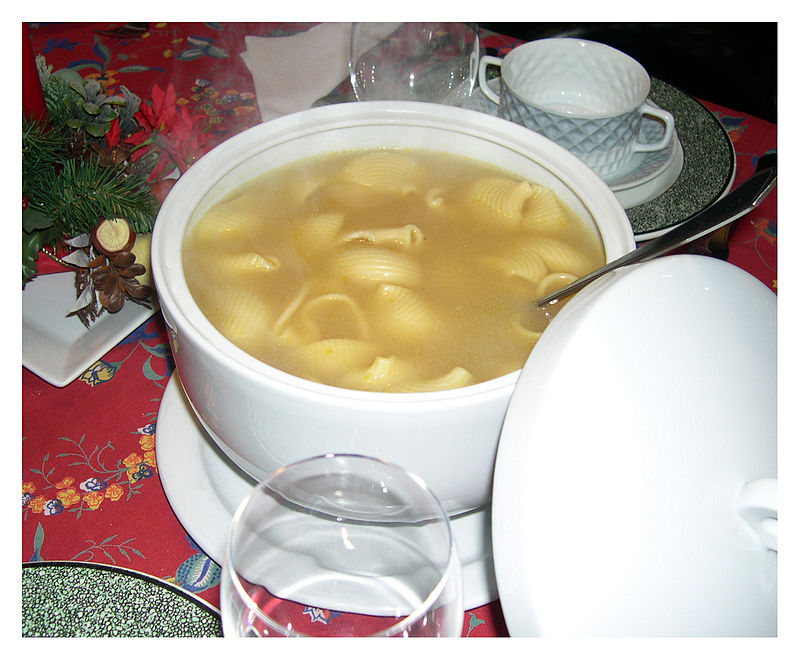 |
| Shell up! |
Tradition says the stew should include four types of meats, including a giant garlic-and-parsley meatball called a pilota. The stew’s trademark characteristic is its gelat, huge shell-shaped noodles sold in many stores in the cities around Christmas.
The King’s Cake: Royally Delicious
As Three Kings Day approaches, Barcelona bakeries begin to advertise a special cake they make specifically for the Jan. 5 holiday.
A king cake is usually round, made with pastry-style dough and sometimes decorated with dried fruit which is sometimes dyed with bright colors. It includes a crown which families place on top of the cake. The cake is eaten on Three Kings Day.
It’s traditional to place a figurine of baby Jesus (or candy) in or under the cake. Whoever receives the slice with the figurine, depending on the family tradition, receives good luck or special privileges for the day.
 |
| Who will be the lucky one? |
Caganer close-up photo credit: T.J. DeGroat , Flickr Creative Commons
Caganer in stable photo credit: SteveR-, Flickr Creative Commons
Cagatio photo credit: Valerie Hinojosa, Flickr Creative Commons
Turron photo credit: Vicens.com
Escudella photo credit: Wikipedia
King’s Cake photo credit: Francisco Huguenin Uhlfelder, Flickr Creative Commons
Caganer variety photo credit: Ajuntamient Barcelona, Flickr Creative Commons
Christmas photo credit: Ajuntamient Barcelona, Flickr Creative Commons






